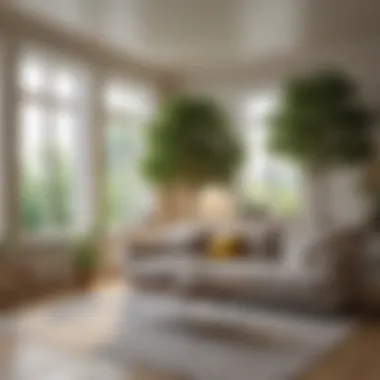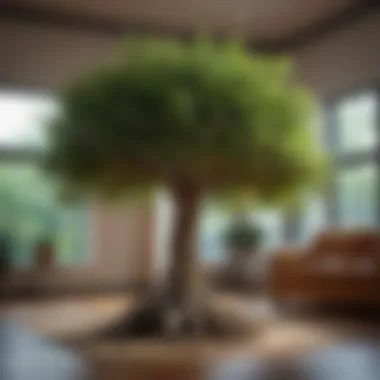Top Apartment Trees for Indoor Living Spaces


Intro
In urban living, the introduction of greenery into residential spaces can elevate the atmosphere significantly. Trees, in particular, bring a unique flair that contributes not only to visual appeal but also to air quality and overall well-being. However, not all trees are suited for apartments.
Apartment inhabitants need to consider three main aspects when selecting trees: size, light accessibility, and maintenance requirements. It’s crucial to choose tree species that can thrive in indoor settings, adapting to lower light levels and confined spaces while still providing the benefits of nature.
In the following sections, we will explore a variety of trees that are ideal for apartment living. We will examine each species’ characteristics, care instructions, and any special considerations to keep in mind. By selecting the right tree, residents can create a more inviting and healthier home environment.
Preface to Apartment Trees
In urban settings, where space is often limited, introducing greenery into living spaces can seem challenging. However, choosing the right trees can significantly enhance the indoor environment of apartments. The topic of apartment trees is crucial as it focuses on the selection of trees that flourish in confined spaces while also considering aesthetic sensibility and the well-being of residents.
Apartment trees are not merely ornamental; they provide several benefits that can improve the quality of life. Their presence can create a sense of tranquility, elevate the mood, and promote a connection to nature, which is often missing in city life. With careful selection, these trees can transform an ordinary apartment into a serene retreat.
Moreover, the incorporation of trees within apartments contributes positively to the air quality. They naturally filter pollutants and increase humidity, thereby creating a healthier living environment. For many apartment dwellers, the transformative power of trees can lead to enhanced emotional and psychological well-being.
When considering trees for apartment living, several factors must be taken into account. The size of the tree, its light requirements, and its maintenance needs all play a vital role in ensuring the tree’s growth and the comfort of the residents.
"Integrating trees into apartment design is not just about aesthetics; it's a step toward enhancing life quality in urban environments."
As we navigate the subsequent sections, a detailed examination of the myriad benefits and considerations will be outlined. This understanding equips readers with the necessary knowledge to make informed decisions on which trees will harmoniously coexist within their living spaces. By choosing wisely, the integration of these trees can evoke a cherished, vibrant atmosphere in urban homes.
Benefits of Having Trees in Apartments
Incorporating trees into apartment living offers various benefits that enhance both the environment and the living experience. Understanding these advantages allows residents to make informed decisions when selecting indoor greenery. Trees not only improve the aesthetics of a space but also contribute significantly to health and mental well-being.
Aesthetic Enhancement
Trees add a natural beauty to apartment interiors. Their presence can transform a plain room into a vibrant and inviting space. Various species, with their unique shapes and foliage, provide opportunities for personalization and style. For example, the lush leaves of a Fiddle Leaf Fig or the robust presence of a Rubber Plant can serve as focal points in any room. Adding greenery creates a more lively and warm atmosphere, helping to reduce the often impersonal feel of modern apartments.
Improved Air Quality
Another notable benefit of having trees indoors is the improvement of air quality. Trees and indoor plants contribute to higher oxygen levels and can filter pollutants from the air, including formaldehyde, benzene, and other harmful chemicals. Research indicates that keeping plants indoors can reduce indoor air pollution and enhance overall respiratory function. The addition of trees aids in creating and maintaining a healthier living space, especially in urban environments where air quality may be compromised.
Psychological Benefits
The psychological impact of greenery in living spaces is profound. Numerous studies showcase the positive relationship between indoor plants and mental health. Interaction with plants is known to reduce stress levels, enhance mood, and promote feelings of well-being. The presence of trees in apartments can create a calming and relaxing environment that encourages a sense of peace. Moreover, caring for plants can offer a rewarding experience, fostering responsibility and a connection to nature. This connection is vital in today's fast-paced urban life where individuals often feel disconnected from the natural world.
"Incorporating greenery into apartment life not only beautifies the space but also nurtures the mind and body."
Overall, the benefits of adding trees to apartment settings are multifaceted, impacting aesthetics, air quality, and psychological well-being. Such elements make them invaluable additions for any apartment dweller.
Criteria for Selecting Apartment Trees
Choosing the right tree for an apartment is essential for ensuring a healthy and thriving indoor environment. The factors that influence this choice include size, light requirements, and maintenance needs. Each of these criteria plays a crucial role in determining which species will flourish in your unique living space. When selecting a tree, it's important to consider your lifestyle, the specific conditions within your apartment, and the visual appeal you desire. By aligning these criteria with the characteristics of potential tree species, residents can create a balanced indoor ecosystem that enhances both aesthetics and functionality.
Size Considerations
Size matters significantly when selecting trees for apartments. Many trees can grow larger than expected, which may pose challenges in compact spaces. It is critical to recognize the mature size of any tree species before making a decision. For example, the Fiddle Leaf Fig can reach significant heights if left unpruned, which might not be suitable for average ceilings in urban apartments.
When choosing a tree, consider the following:


- Measure the available space: Ensure your selected tree will fit comfortably without overcrowding the area.
- Think about growth patterns: Select species known to grow more compactly or those that are conducive to pruning, like the Dracaena.
- Plan for future growth: Trees often continue to grow even with ideal conditions, so anticipate their long-term needs.
Light Requirements
Light requirements are fundamental to the well-being of indoor trees. Different species have varying needs for sunlight, ranging from direct to indirect light. It's crucial to evaluate your apartment's natural light conditions.
- Assess light exposure: Rooms with large windows may allow for sun-loving species, whereas dimly lit areas may require shade-tolerant trees like Chinese Evergreen.
- Use artificial lighting: If natural light is limited, consider augmenting it with grow lights to simulate the necessary conditions for your selected tree species.
- Rotate trees as needed: Positioning can affect how trees respond. Regularly rotate your tree to ensure even exposure to light, which promotes healthier growth.
Maintenance Needs
Maintenance requirements can dictate the practicality of keeping a tree in an apartment. Understanding the level of care a tree needs can help prevent that item from becoming a source of stress rather than enjoyment.
- Watering schedule: Some trees, like the Rubber Plant, require more frequent watering, while others may thrive on less. Knowing your plant's needs will lead to better growth.
- Fertilization: Different species may have unique nutrient needs. For instance, Pothos thrive on a balanced fertilizer in the growing season, while the Chinese Evergreen may require less frequent feeding.
- Pest management: Regularly inspecting your tree can help catch any pest infestations early. Understanding how to deal with common problems will ensure a healthier plant.
Popular Tree Species for Apartments
Choosing the right tree species for an apartment is essential for enhancing the living space. Each species comes with unique characteristics that appeal to various tastes and requirements. Residents of apartments often seek trees that offer versatility, aesthetic appeal, and easy maintenance. This section discusses popular tree species that thrive in indoor environments, ensuring that your selection aligns with both your lifestyle and the conditions of your apartment.
Fiddle Leaf Fig
Care Requirements
The Fiddle Leaf Fig is known for its striking large leaves and impressive height. This tree requires bright, indirect light, making it suitable for sunny corners of a room. It needs moderate watering, allowing the soil to dry slightly between sessions. Overwatering can lead to root rot, which is a common issue with this plant. Because of its specific care needs, the Fiddle Leaf Fig often attracts those willing to invest time in plant maintenance, which enhances their connection to nature indoors. Its bold appearance makes it a popular choice for modern apartments.
Size and Growth Patterns
Fiddle Leaf Figs can grow quite tall, often reaching up to six feet or more if conditions are optimal. Their upright growth pattern makes them excellent focal points in a room. However, indoor growth is affected by light and space. Taller specimens may require ceiling height consideration when placed in apartments. While this species enhances vertical space, its size must be managed to avoid crowding. Homeowners should evaluate their available space before committing to this impressive plant.
Rubber Plant
Light and Water Needs
The Rubber Plant thrives under low to bright indirect light, which makes it adaptable to various apartment settings. It requires consistent watering, but like the Fiddle Leaf Fig, it doesn’t appreciate overly wet soil. Its glossy leaves not only beautify your space but also contribute to better indoor air quality. Rubber Plants are a compelling choice for those looking for a resilient yet stylish houseplant. With proper light and watering routine, it can flourish and add greenery without overwhelming your living space.
Benefits and Drawbacks
The benefits of the Rubber Plant include its air-purifying qualities and resilience in different environments. The plant can grow to a considerable height but can also be pruned to maintain a desired size. However, it does shed leaves occasionally, which may create a mess. Residents should consider this aspect when deciding if this plant fits in their apartment regime wisely. The balance of appeal and maintenance makes it a worthy contender for apartment living.
Pothos
Ease of Care
Pothos is especially well-known for its forgiving nature. This species can tolerate low light and irregular watering schedules, making it ideal for busy lifestyles. Its trailing vines can add a natural touch to hanging baskets or shelves. The straightforward care requirements alleviate stress for apartment dwellers who may not have a green thumb. In terms of adaptability, Pothos works well in various environments, ensuring its popularity among plant owners.
Adaptability
Pothos is not only easy to care for but also adaptable to various lighting conditions, from low-light to bright indirect light. This versatility allows it to thrive in almost any apartment setting. Moreover, it can grow in soil or even in water, making it an excellent choice for those experimenting with different indoor gardening techniques. While it’s a boon for many, its rapid growth may necessitate occasional trimming to maintain desired aesthetics in the apartment.
Chinese Evergreen
Growth Characteristics
Chinese Evergreens are characterized by their lush foliage and ability to thrive in low-light conditions. They come in various varieties, showcasing different leaf colors and patterns. This adaptability makes them suitable for various apartment settings, and they tend to grow slowly, which is advantageous for residents looking for a plant that maintains a manageable size. This species is straightforward to care for, making it appealing for both beginners and experienced plant owners.


Cultural Significance
In many cultures, the Chinese Evergreen is associated with good luck and prosperity. This cultural significance adds an extra layer of allure for potential owners, particularly those interested in Feng Shui. Placing this plant strategically within an apartment could potentially enhance the positive energy flow. Such connections are worth considering for apartment dwellers aiming to foster a peaceful living environment with meaningful plant companions.
Dracaena
Varieties and Features
Dracaena is a broad family that includes many types, each differing in size and appearance. This diversity allows for choices that can match diverse decor themes in a home. Most varieties prefer bright, indirect light and require minimal watering, aligning with the lifestyle of many urban residents. These plants can serve as backdrop pieces in larger spaces or focal points in smaller areas. Their flexibility in appearance and care makes Dracaena an attractive option for apartment living.
Maintenance Tips
Maintaining Dracaena is generally simple. Regular dusting of the leaves is recommended to keep plants healthy and vibrant. Occasionally rotating the plant helps ensure even growth, as it naturally gravitates towards light. Moreover, slightly reducing watering during the winter is essential, as this species enters a dormant phase. Such maintenance tips contribute to its longevity, making it a reliable choice for those wanting to enjoy greenery without extensive care demands.
"Choosing the right trees can transform your apartment into a personal sanctuary. Consider your space and lifestyle carefully."
Incorporating trees such as Fiddle Leaf Figs, Rubber Plants, Pothos, Chinese Evergreens, and Dracaena can significantly impact apartment living. Each species offers unique benefits, allowing residents to find the perfect match for their homes. It is essential to analyze the specific needs of each tree and how they will fit within your apartment's environment.
Care Tips for Apartment Trees
Caring for apartment trees is crucial for their survival and overall health. In the limited environment of an apartment, understanding specific care strategies can make the difference between a thriving plant and one that struggles. Each tree species has its own unique requirements. Therefore, following general care tips helps ensure that the tree flourishes in its indoor environment. Adopting these practices contributes not only to the aesthetics of the space but also improves the air quality and enhances the ambiance. Here are key aspects to focus on:
Watering Practices
Watering is a fundamental aspect of plant care, yet it is often misunderstood. Overwatering or underwatering can stress plants, leading to root rot or dehydration. Understanding the needs of your tree is vital. Each tree species has different watering requirements based on their size and water retention capabilities. For instance, trees like the Fiddle Leaf Fig prefer their soil to dry out a bit between waterings, while Rubber Plants enjoy consistently moist soil. A good practice is to check the top inch of soil; if it's dry, it is typically time to water.
Fertilization Recommendations
Fertilizing provides essential nutrients that trees may not get from soil alone. Selecting the right fertilizer is important. Many indoor trees benefit from a balanced liquid fertilizer during the growing season, which is typically spring and summer. Low doses, used every four to six weeks, help prevent nutrient burn. It's prudent to avoid fertilizing during the dormant season in winter. Some signs that a tree needs fertilization include stunted growth or yellowing leaves. Regularly evaluating the tree's health can inform fertilization needs.
Pruning and Maintenance
Pruning is a necessary practice for maintaining the shape and health of trees in apartments. Regularly removing dead or damaged leaves encourages new growth and helps prevent disease. Different tree types will require different pruning techniques. For example, you can prune Dracaena plants by cutting the stems back to their desired height. It's also helpful to clean leaves occasionally, removing dust that can inhibit photosynthesis. This simple act can enhance the tree's overall health and appearance.
Choosing the Right Pot for Your Tree
Selecting the right pot is crucial for the successful growth and health of your indoor tree. A pot is more than just a container; it serves as the environment where the tree gets its nutrients, retains moisture, and allows roots to grow and breathe. Therefore, understanding the importance of pot size, material, and drainage can lead to a happier, healthier plant.
Size and Material Options
When it comes to choosing the size of the pot, the general rule of thumb is to pick a pot that is 2 to 4 inches wider in diameter than the current container of your tree. This extra space gives the roots room to expand. If the pot is too small, roots can become root-bound, which leads to poor growth and overall decline in health. Properly sized pots promote robust root systems.
As for material, pots can be made from plastic, terracotta, ceramic, and metal, each having its own advantages.
- Plastic pots are lightweight and generally cheaper. They retain moisture well but should be checked regularly to avoid overwatering.
- Terracotta pots are porous and allow for better air circulation and drainage, making them suitable for plants that prefer drier conditions.
- Ceramic pots, often glazed, add aesthetic value but can retain moisture more than terracotta.
- Metal pots, although stylish, may heat up quickly and lead to uneven moisture retention.
Drainage Implications
Drainage is paramount in pot selection. Without proper drainage, excess water can lead to root rot, a common issue in indoor trees. Always choose a pot with drainage holes at the bottom. If the pot does not include drainage, consider placing a layer of rocks or gravel at the bottom to help facilitate water movement.
Key considerations for drainage include:


- Ensuring that excess water can escape freely.
- Using potting soil that promotes good drainage, such as those with perlite or vermiculite.
- Monitoring water retention and adjusting watering schedules based on the potting material's drying time.
"Choosing the right pot is not just a matter of aesthetics; it impacts the health and growth of your indoor tree significantly."
Taking into account both size and drainage can create the ideal environment for your tree. A pot that fits well and allows for adequate drainage will lead to flourishing leaves and a vibrant indoor atmosphere.
Common Issues and Solutions
Recognizing common issues and devising effective solutions can make a significant difference in the health of apartment trees. When living in confined spaces, maintaining indoor greenery can present unique challenges. Understanding these challenges allows apartment dwellers to take proactive measures. This section highlights the common problems that trees might encounter in apartment settings and outlines solutions to mitigate these concerns, ensuring a thriving indoor ecosystem.
Pests and Diseases
Pests and diseases pose a serious threat to the health of indoor trees. Common pests such as spider mites, aphids, and mealybugs can infest plants, leading to weakened growth and overall decline. Diseases like root rot can result from overwatering and poor drainage. To prevent these issues:
- Routine Inspections: Regularly examine your trees for signs of pests or disease. Look for unusual discoloration, spots on leaves, or any sticky residue.
- Natural Remedies: Consider using neem oil or insecticidal soaps to treat infestations. These organic options can be effective without harming the plant.
- Proper Drainage: Ensure pots have sufficient drainage holes to prevent root rot. Always allow the soil to dry out slightly before watering again.
Implementing these strategies can help maintain the vitality of your indoor trees, ensuring they remain healthy and vibrant.
Environmental Stress
Environmental stress can greatly affect indoor trees, particularly in apartments with varying light conditions and temperature fluctuations. Factors like drafts, humidity, and limited light can lead to stress symptoms such as leaf drop or stunted growth. To mitigate these stressors:
- Maintain Consistent Lighting: Position trees near suitable light sources, ensuring they receive adequate sunlight without direct harsh rays.
- Monitor Temperature: Keep indoor trees away from heat sources like radiators or air conditioners. A stable temperature range between 65°F and 75°F is ideal for most indoor trees.
- Humidity Control: Indoor environments often lack humidity, which can stress plants. Use a humidifier or pebble tray method to boost humidity levels around your trees.
Addressing environmental stress will substantially improve the health and growth potential of your indoor trees. Regular monitoring and adjustments can lead to a thriving living space filled with greenery.
Understanding and resolving common issues can greatly enhance the experience of growing trees in an apartment, making the integration of nature into your living space a rewarding endeavor.
By tackling these challenges, apartment dwellers create a more welcoming and healthy space for their indoor trees.
Design Tips for Incorporating Trees into Your Apartment
Incorporating trees into apartment spaces is not just about adding greenery; it significantly enhances the aesthetic value and contributes to improved well-being. These living elements can provide a refreshing contrast to modern interiors while improving air quality and mood. The following subsections offer practical strategies for successfully integrating trees into your apartment design, ensuring that they complement your style and serve their purpose effectively.
Arrangement Strategies
When placing trees in your apartment, consider both their size and the available light. Position trees in areas that receive ample natural light, as most trees thrive in bright environments. Here are some arrangement strategies:
- Corner Placement: Utilize corners by placing taller trees, such as the Fiddle Leaf Fig. This not only maximizes space but also draws the eye upward, giving a sense of height to the room.
- Grouping: Place smaller trees together in a cluster for an interesting focal point. This works well with trees like Pothos, which can drape over shelves or stands, adding layers to your design.
- Window Ledges: Utilize window spaces for trees that do not require too much width but enjoy bright light, like the Rubber Plant. This also provides necessary sunlight, essential for healthy growth.
- Dividing Spaces: Use trees as natural dividers in open floor plans. Placing a Dracaena or Chinese Evergreen in large pots can help distinguish between different functional areas such as living and working spaces.
Tip: Ensure that tree placement allows for airflow and does not obstruct pathways. Keeping things open makes the space feel larger and more inviting.
Complementing Existing écor
To create a cohesive look, it is essential to complement your existing décor with the trees you select. Here are strategies to harmonize trees with your apartment’s style:
- Color Coordination: Match your tree pot to existing color themes in the room. Neutral-colored pots can frame vibrant green leaves while metallic finishes add a modern touch.
- Texture Mixing: Combine different textures. For instance, a smooth ceramic pot with a coarse natural wood tree trunk can create visual interest.
- Height Variation: Ensure there is a variety of heights among your trees and other decorative elements. Mixing low and tall trees can add dimension to the room.
- Seasonal Accents: Consider changing the display based on seasons. Add decorative stones or seasonal ornaments around the base of your tree to keep the look fresh throughout the year.
Integrating trees into your apartment effectively requires thoughtful consideration of their placement and visual harmony with your decor. By applying these design tips, apartment dwellers can create an inviting and vibrant atmosphere that embodies the beauty of nature even in limited spaces.
Finale
In this discussion, we emphasize the crucial role that trees play in apartment living. Selecting the right trees is not just about aesthetic enhancement; it has profound implications for the overall living environment. The presence of trees improves air quality, which is vital in confined spaces where air circulation can be limited. Additionally, trees contribute to psychological well-being, offering a natural touch that can alleviate stress and create a sense of tranquility in our everyday lives.
When considering the integration of trees into an apartment, factors such as size, light needs, and maintenance requirements cannot be overlooked. Understanding these elements helps ensure that the trees thrive in indoor settings without becoming a burden. For instance, the Fiddle Leaf Fig adds considerable visual appeal, while the Rubber Plant is known for its air-purifying qualities.
We also discussed practical care tips that ensure healthy growth without excessive effort. Proper watering practices, the right potting materials, and timely pruning are fundamental to maintaining indoor greenery. Often, minor adjustments can lead to significant improvements in the health of indoor trees.
Incorporating trees thoughtfully into your apartment not only enhances the interior but also nurtures a deeper connection to nature. This connection can foster a sense of peace and enhance the quality of life for tenants. Therefore, the decision to include trees in apartment spaces should be made with careful consideration of both their benefits and the specific conditions of the environment.



